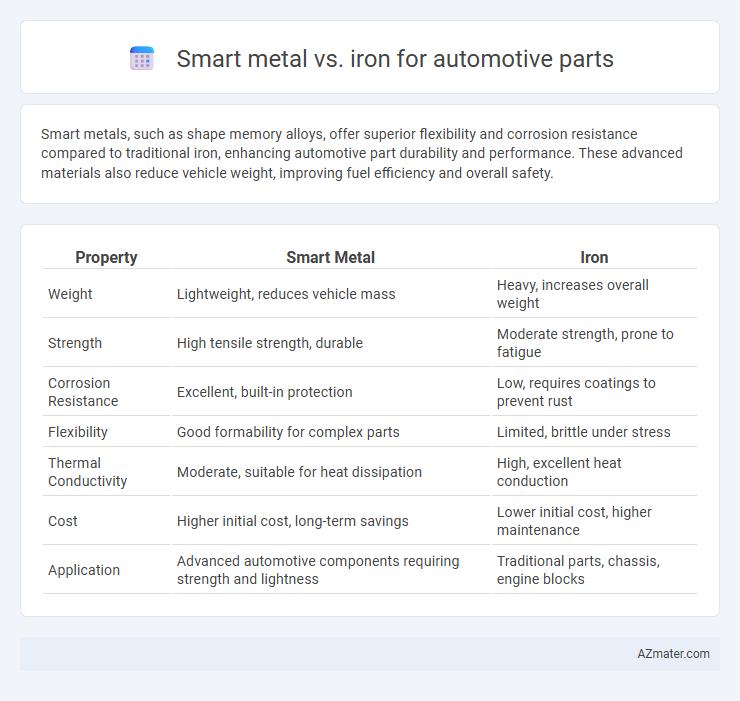Smart metals, such as shape memory alloys, offer superior flexibility and corrosion resistance compared to traditional iron, enhancing automotive part durability and performance. These advanced materials also reduce vehicle weight, improving fuel efficiency and overall safety.
Table of Comparison
| Property | Smart Metal | Iron |
|---|---|---|
| Weight | Lightweight, reduces vehicle mass | Heavy, increases overall weight |
| Strength | High tensile strength, durable | Moderate strength, prone to fatigue |
| Corrosion Resistance | Excellent, built-in protection | Low, requires coatings to prevent rust |
| Flexibility | Good formability for complex parts | Limited, brittle under stress |
| Thermal Conductivity | Moderate, suitable for heat dissipation | High, excellent heat conduction |
| Cost | Higher initial cost, long-term savings | Lower initial cost, higher maintenance |
| Application | Advanced automotive components requiring strength and lightness | Traditional parts, chassis, engine blocks |
Introduction to Smart Metal and Iron in Automotive Parts
Smart metals, such as shape memory alloys and auxetic metals, offer adaptive properties like self-healing, shape retention, and enhanced durability, making them ideal for innovative automotive parts that require responsiveness to environmental changes. Iron, particularly cast iron and steel variants, remains a fundamental material in automotive manufacturing due to its strength, cost-efficiency, and machinability for components like engine blocks and chassis parts. The automotive industry is increasingly integrating smart metals to improve performance and reduce weight while relying on iron for its structural stability and load-bearing capabilities.
Key Differences Between Smart Metal and Traditional Iron
Smart metal, typically composed of shape memory alloys (SMAs) such as nickel-titanium (Nitinol), offers enhanced flexibility, corrosion resistance, and weight reduction compared to traditional iron used in automotive parts. Unlike iron, which is prone to rust and has limited deformation capacity, smart metal can return to its original shape after bending or impact, improving durability and crash resilience. These properties of smart metal contribute significantly to the development of lightweight, efficient, and longer-lasting automotive components.
Strength and Durability: Smart Metal vs Iron
Smart metal alloys used in automotive parts offer superior strength-to-weight ratios compared to traditional iron, enhancing vehicle performance and fuel efficiency. These advanced materials exhibit higher tensile strength and better resistance to fatigue, directly contributing to longer durability under dynamic stress. Iron, although robust, tends to be heavier and more prone to corrosion, making smart metals a preferred choice for modern automotive applications requiring enhanced strength and longevity.
Weight Considerations in Automotive Design
Smart metals, such as aluminum alloys and magnesium composites, are increasingly preferred over traditional iron for automotive parts due to their significantly lower density, which reduces overall vehicle weight and improves fuel efficiency. Iron, while durable and cost-effective, is much heavier and contributes to increased vehicle mass that can negatively impact acceleration, handling, and emissions. Lightweight smart metals enable designers to achieve strong, resilient automotive components that enhance performance while meeting stringent environmental regulations.
Corrosion Resistance: Enhancing Vehicle Longevity
Smart metals, such as aluminum alloys and stainless steel, exhibit superior corrosion resistance compared to traditional iron used in automotive parts, significantly enhancing vehicle longevity. These materials prevent rust formation through protective oxide layers or alloying elements, reducing maintenance costs and extending the service life of components like body panels and engine parts. Incorporating smart metals leads to improved durability in harsh environmental conditions, ensuring sustained vehicle performance and structural integrity.
Cost Analysis: Smart Metal Versus Iron Components
Smart metal automotive parts offer significant cost advantages over traditional iron components due to their lighter weight, which reduces fuel consumption and improves vehicle efficiency. Manufacturing smart metals often involves advanced processes that slightly increase upfront costs but result in lower maintenance and longer lifespan, decreasing total ownership expenses. Iron components, while cheaper initially, tend to incur higher costs over time because of their susceptibility to corrosion, heavier weight, and increased wear and tear.
Manufacturing Flexibility and Innovation
Smart metal offers superior manufacturing flexibility compared to traditional iron, enabling complex shapes and lightweight designs essential for modern automotive parts. Its ability to undergo advanced processes like additive manufacturing and precise alloying facilitates innovative solutions that enhance vehicle performance and fuel efficiency. Smart metal materials also support rapid prototyping and customization, driving continuous innovation in automotive manufacturing.
Environmental Impact and Sustainability
Smart metals used in automotive parts, such as shape memory alloys and advanced lightweight composites, offer significant environmental benefits by reducing vehicle weight and improving fuel efficiency, thereby lowering carbon emissions. Unlike traditional iron components, smart metals often require less energy-intensive processing and are more easily recyclable, contributing to sustainable manufacturing practices. The enhanced durability and corrosion resistance of smart metals extend the lifespan of automotive parts, reducing waste and resource consumption over time.
Performance Benefits in Modern Vehicles
Smart metals, such as shape memory alloys and magnetostrictive materials, offer superior performance benefits over traditional iron in automotive parts by delivering enhanced flexibility, weight reduction, and energy efficiency. These advanced metals improve vehicle durability and safety through their ability to recover original shapes after deformation and provide adaptive responses to stress and temperature changes. Incorporating smart metals in modern vehicles leads to better fuel efficiency, reduced emissions, and longer component lifespans compared to conventional iron-based parts.
Future Trends: The Shift Towards Smart Metal in Automotive Industry
Smart metals in automotive parts are increasingly favored over traditional iron due to their enhanced properties such as self-healing, shape memory, and corrosion resistance, which improve vehicle durability and performance. Innovations in smart alloys and metal matrix composites are driving lightweight construction and energy efficiency, aligning with stringent emission regulations and sustainability goals. The future automotive industry is set to integrate smart metals extensively, supporting electric vehicle advancements and autonomous driving technologies with improved safety and reliability.

Infographic: Smart metal vs Iron for Automotive part
 azmater.com
azmater.com